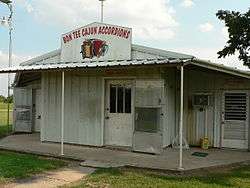Cajun accordion
|
An Acadian brand Cajun Accordion | |
| Other names | diatonic button accordion, melodeon |
|---|---|
| Classification | Free-reed aerophone |
| Hornbostel–Sachs classification |
412.13 (Reeds vibrate within a closely fitting slot) |
| Developed | 19th century |
| Related instruments | |
| Accordion, Bandoneón, Harmonica, Harmonium | |
| Musicians | |
| Joe Falcon, Iry LeJeune, Amédé Ardoin, "Bois Sec" Ardoin, Nathan Abshire | |
| Builders | |
| Marc Savoy (Louisiana, United States), Eric Martin (France), Larry Miller (Louisiana, USA), Hohner (Germany), *Andre Michot (Louisiana, USA) | |
| More articles | |
| Cajun Music, Cajun, History of Cajun Music | |
A Cajun accordion also known as a squeezebox is single-row diatonic button accordion used for playing Cajun music.
History
Many different accordions were developed in Europe throughout the 19th century, and exported worldwide. Accordions were brought to Acadiana in the 1890s and became popular by the early 1900s (decade),[1] eventually becoming a staple of Cajun music.
Many of the German factories producing diatonic accordions for the United States market were destroyed during World War II. As a result, some Cajuns, such as Sidney Brown, began producing their own instruments, based on the popular one-row German accordions but with modifications to suit the nuances of the Cajun playing style.[2] Since the end of World War II, there has been a surge in the number of Cajun accordion makers in Louisiana, as well as several in Texas.[3]
Construction

The Cajun accordion is generally defined as a single-row diatonic accordion, as compared to multiple-row instruments commonly used in Irish, Italian, polka, and other styles of music. The Cajun accordion has multiple reeds for every button and the number of reeds sounding is controlled by four stops or knobs. The standard amount of melody buttons is ten, with a button each in the left hand for the root note and chord as well as the dominant fifth ditto; C and G in a Cajun accordion tuned to C. The root is played on the push and the fifth is played on the pull of the bellows. [4] Louisiana constructed accordions are usually built in small backyard shops like Marc Savoy's Acadian brand and Larry Miller's Bon Cajun brand. Clarence " junior" Martin of Lafayette Louisiana is a Master Craftsman who also builds beautiful accordions in his shop. His designs and tuning are extraordinary.
Characteristics
The most common tuning utilized is the key of C, although the key of D is also relatively common.[5] Some rarer accordions are constructed to in the key of B flat. Cajun accordions are traditionally tuned to a Just Intonation.
Notable players
Although the instrument is called a Cajun accordion, both zydeco and creole musicians play the Cajun accordion with a zydeco and creole sound respectively. Each musician below is considered important in influencing accordion technique and image.
- Nathan Abshire
- Alphonse "Bois Sec" Ardoin
- Amédé Ardoin
- Jackie Caillier
- Boozoo Chavis
- Geno Delafose
- John Delafose
- Joe Falcon
- Iry LeJeune
- Aldus Roger
- Marc Savoy
- Wayne Toups
- Lee Benoit
- Lawrence Walker
- Jo-El Sonnier
- Jimmy Thibodeaux
Manufacturers and builders
- Hohner (Germany)
- Marc Savoy (Louisiana, USA)
- Eric Martin (France)
- Jr. Martin (Louisiana, USA)
- Randy Falcon (Louisiana, USA)
- Jude Moreau (Texas, USA)
- Bryan Lafleur (Texas, USA)
- Ed Poullard (Texas, USA)
- Andre Michot (Louisiana, USA)
- Ken Guillory (Louisiana, USA)
Gallery
-

Front
-

Keys
-

The front left-hand side (bass side) of a Cajun accordion
-

The knobs or stops control the number of reeds sounding
-

The back side
-
A close up of the keys
See also
- Bandoneon
- Diatonic button accordion
- Piano accordion
- Cajun French Music Association
- List of people related to Cajun music
- History of Cajun music
- Fiddle
References
Miller, Larry; Miler, Mike (1988). You Can Play Cajun Accordion: Designed For Beginners. Point Au Loup Pub. Co. ASIN B00071SMMA.
Savoy, Ann (1986) [1984]. Cajun Music a Reflection of a People. Eunice, Louisiana: Bluebird Press. ISBN 978-0-930169-00-8.
- ↑ You Can Play Cajun Accordion 1988
- ↑ Dôle, Gérard (1977). Traditional Cajun Accordion (Vinyl). Gérard Dôle. New York City: Folkways Records. 8363.
- ↑ List of Cajun accordion Makers
- ↑ Savoy 1984, p. 2.
- ↑ Savoy 1984, p. 1.